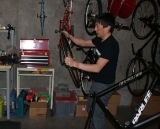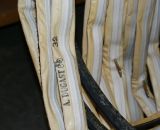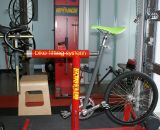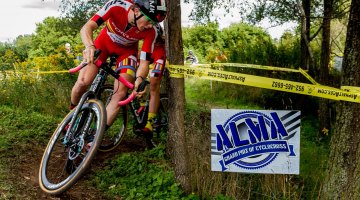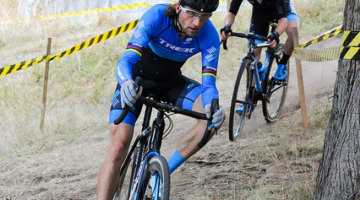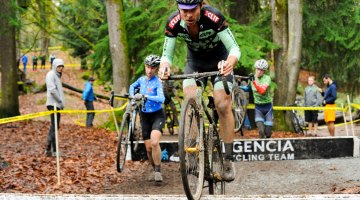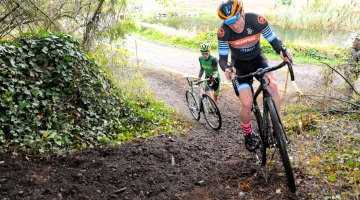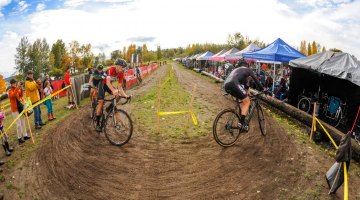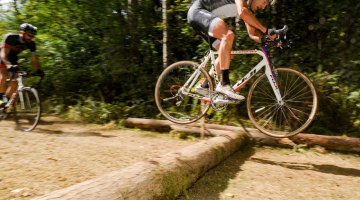Characters of ’Cross: An ongoing series wherein Cyclocross Magazine contributor Kenton Berg badgers, begs and coerces answers and information about the life and times of the personalities who are helping to shape the world of cyclocross as we know it.
This week we feature Zac Daab, co-founder of MFG Cyclocross, founder of Hup United and sole proprietor of Cascade Bicycle Studio, to see what he’s been up to since we last profiled him and the Hup United club in Issue 2.
The Scene:
At first glance, the outside of the Cascade Bicycle Studio (CBS) looks like any one of the many storefronts along the busy 36th Street in Fremont, Washington. Home to restaurants, bars, art galleries and a host of other businesses, this strip is brimming with life. The garage door-style front of the CBS shop allows passersby to look through the many windows and take in the assortment of bike bling that resides inside. Complete bikes and frames from Seven, Focus and Parlee adorn the walls and racks. Lazer helmets, Mavic shoes and wheels, and a host of tubulars working their way through the gluing process fill in the remaining spaces, ready for customer ogling.
As an industry veteran, Zac Daab doesn’t ooze the typical bike scene ego, nor does his casual demeanor hint at the wealth of knowledge and overall passion he has for bikes. As I found, his quiet confidence flows outwardly as the discussion moves on, and ultimately one realizes that there’s tons of experience and know-how hiding within the confines of both his brain and shop.
With this in mind I stepped into his super-clean Cascade Bicycle Studio to have a sit down and find out more about what got him into the business, what he’s got planned for this year with the MFG ’cross series, and what he thinks about some of the things happening in cyclocross.
The Discussion:
CXM: Zac, what was the starting point in bikes for you?
ZD: 8th grade algebra is where it all began. I had an algebra teacher whose son was a few grades ahead. This teacher was always talking about how he was racing mountain bikes and working in a shop. I had no idea about racing mountain bikes at the time, but I did own one, a Specialized Rockhopper. This piqued my curiosity and I ended up working at the shop, doing his old job of bike assembly and taking out the cardboard, which, by the way, I still do today at my shop. This grunt work led me to riding more with the shop people and racing, which then led to riding road bikes. After that it was all bikes, all the time.
CXM: When did ’cross come into the picture?
ZD: 1998/99 in Seattle was my starting point in ’cross, in the era of Dale Knapp and Craig Undem. SeaTac Nats, Undem on the cover of VeloNews, those were memorable moments and a great starting point for me. After that I was hooked on ’cross.
CXM: I understand you had a significant role at Seven Cycles. Was that your real starting point in the bike business?
ZD: My real starting point was the bike shop that I mentioned. That experience of 10-or-so years working in a shop started it. After that I worked for REI in Seattle and then for Patagonia as a liaison for the clothing demo program. Working for Patagonia brought me to Interbike, and I ended up talking to the folks at the Seven booth, since I had a Seven mountain bike, and found out that they were hiring. The rest, as they say, is history, and I ended up getting a job with them in Boston in 2000. When I left Seven I was the Senior Fit Technician after having spent some time as a Sales guy, so I got a good mix of experience.
CXM: Given that you were in a significant role at Seven what was the impetus to start your own business?
ZD: It was really a timing thing. At the time I had a friend in Seattle who was running a shop, similar to mine today, and he was a Seven retailer. When I was out visiting him, he told me he was closing his shop and that there wouldn’t be a Seven dealer in Seattle after that. That got the wheels spinning and I realized that I could fill a void. I really wanted to get back to Seattle, so that was the real catalyst. I ended up leaving Seven and was able to work out the relationship with them to carry the brand in the shop. I knew that having the Seven brand would be critical for success, but it was not a guarantee that they would do this. In the long term this has worked out really well, I believe, for both parties.
CXM: So how long has the CBS Studio been around now?
ZD: Five years now. We just had our fifth anniversary, and the business is doing well. We’ve been profitable since opening and our customers seem to be really happy. I’m now spending time trying to figure out what other products, services or other things that the customer base would want to have or need.
CXM: What’s the most demanding part of being a shop owner and a promoter?
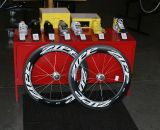
Plenty of eye candy at CBS for cyclists with interests in the various disciplines: Description: Zipp track wheels await a customer ©Kenton Berg
ZD: The most demanding part is being a promoter and promoting my shop through the series. I guess what I mean is that when I’m at MFG races, I’m full-on MFG and the shop is secondary. The opportunity is there to fill some voids at the races that would benefit the shop, but I just don’t have the bandwidth to do this. I see the need, and opportunity, for some value-add services the shop could provide, but since I’m a one-man show I can’t do both at one time.
CXM: What led to the creation of the MFG series—your other job, in effect?
ZD: Well, it was really my desire to create something new and different for ’cross in Seattle, an alternative to the existing ’cross racing happening in the area. I originally approached Terry (Buchanan) with the idea, and he said no. We then talked again and he asked me to convince him it was a good idea and look what happened, it was a good idea! What we saw was an opportunity to take the enthusiasm for ’cross in Seattle and to do something different with it. I knew that we had the base to support two different series and multiple races. The racers are jazzed with the opportunity to race twice as many races as there were before.
CXM: How has the “Coopetitiion” with the Seattle Cyclocross worked out?
ZD: It has actually gone very well. Terry has a long-term friendship with Jerry (Baker) at SCX and we didn’t want to try and really compete with them, just to add to the amount of ’cross in Seattle. This ended up working out really well for all of us, including racers. We’ve worked around the traditional dates that the SCX series has run and made it a solid ’cross season in Seattle between the two series. The real difference is that SCX is a USAC series and we are not. In the end, this opens the door for a lot of people to race at our races without a license being a barrier to entry.
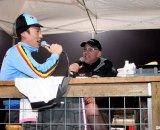
Zac Daab has worked with Terry Buchanan on Star Crossed for a long time, including several stints as an announcer. © Cyclocross Magazine
CXM: What’s new this year with MFG?
ZD: Well, nothing huge, but StarCrossed is changing venues this year. We’ll be holding it at the raceway venue (Pacific Raceways in Kent, Washington) where the Single Speed Cyclocross Worlds were last year. Marymoor, the traditional venue, is hosting a huge Susan G. Komen three-day event and isn’t available to us, so we’ve worked with the private land owners at the raceway to hold it there. It’s going to be cool, we have lots of terrain to work with and will be able to have multiple beer gardens. Since this is private land we have lots of options available. The format will still be the same with the Elite races going off under the lights.
Outside of that, we’ll be going to many of the same venues as last year, including Woodland Park, which has gotten so much positive feedback from the community. I still run into people who talk about having been to a race there and they ask me if I knew anything about it and talk about how cool it was to have a race so close to their house. It’s really a cool thing.
CXM: How about thoughts on the fields and the TT at Nationals in Bend?
ZD: Despite the TT and all the work in trying to get the seedings right, we still had a crash in the front of the field in the Masters 35-39. I mean, come on, the guys who are supposed to be the fastest are crashing! But it goes to show you that the speed in a short TT doesn’t mean that they have the experience to handle the crowd at a mass start ’cross race. Therefore, you have a flaw to that system. I liked the fact that USAC was trying to handle the masses in an effective manor, but you also added one day to everyone’s trip. This is certainly good for the host city, but it does add time and expense for the rider.
CXM: So what do you think will happen at this next Nats regarding field size?
ZD: Actually I think there will be a huge draw, not likely as big as Bend due to the timing of coming after New Years, but my guess is it will be over a 1,000 riders. The Midwest, Chicago and surrounding areas will prove to be a great regional draw for the event. Look at Bend—how many Northwest area riders, or California, Utah, Idaho riders were there? Lots. It was a huge regional event, and then others came from all over.
CXM: What do you think about Worlds in 2013 in Louisville?
ZD: This is going to be a very cool event, but I still believe there are a lot of people in the US who think that they can show up in Louisville and there will be a race for them to participate in. We are so used to participating in races and then watching others later in the day, that this will be a complete change for people. My question is: how many people are going to fly in there to watch racing for a day or two? I’m sure there will be some, but I think it will be a somewhat regional event as well. This is just not what we are accustomed to in the U.S.
CXM: What are your thoughts on getting more Junior racers into the sport?
ZD: I think you have to look at what you’re trying to accomplish with getting more Juniors into the sport. Is it that you want to grow world champions, or just increase participation? One of the big things about getting the younger age groups into cycling in general is that it is a lifelong sport versus some of the ball and stick type sports. Lots of people have been riding bikes since they were kids, but they stopped playing football after high school. In effect, once you get away from your “four-year” activity you might tend to slack off and do less physically. Ultimately, you can ride you bike, whether you race or not, for a long time and reap the heath benefits.
CXM: What’s your social media usage and how do you think it plays into cycling?
ZD: Facebook for MFG, Twitter for MFG and also for my shop. It makes sense for us to use these mediums for posting or soliciting info. It’s a limited thing, but it has its place. I think it has been good for cycling in that it has made the sport more intimate. Not only can you get very close to the pros at races, but you’re hearing and seeing more from them than ever before. But it’s not without its downsides as well, as rumors or negative news are spread too fast. I guess some of it is up to the readers and how they view the info through his or her “lens.”
CXM: Last question: if you could only have one bike, or one brand of bike, what would it be?
ZD: Brand or bike would be Seven, no question about it. I know the brand, the quality of the brand, there’s just too much there to go elsewhere.
Much thanks to Zac for taking the time to talk and share his thoughts with us. For more on Zac’s cyclocross activities, see MFG Cyclocross and Cascade Bicycle Studio. Also see our feature on Zac and the national cyclocross-oriented club, Hup United, in an early edition of our print magazine, Issue 2.













